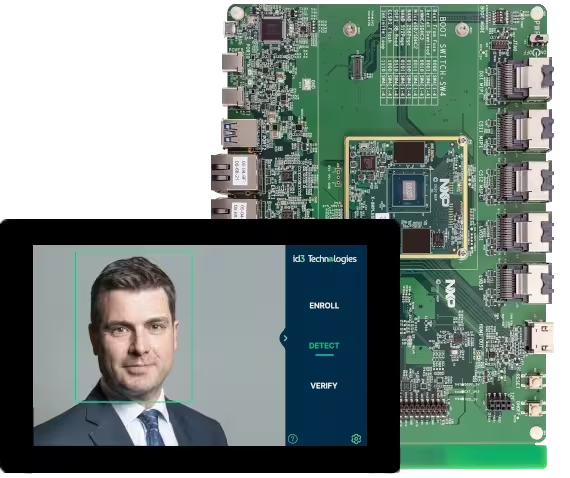Quickly Test our face recognition technology on i.MX 8M Plus platform.
MicroFace i.MX 8M Plus kit allows users to test the basic functionality of our facial recognition SDK for platforms based on the i.MX 8M Plus processor. We have optimised our algorithms to work on embedded targets with AI processing resources. This solution makes it possible to develop facial recognition applications on embedded systems, reducing development costs.
Discover all the features of our microFace starter kit.
Face capture
Compatible with a wide range of cameras from leading manufacturers, ensuring versatile and comprehensive biometric data acquisition.
Feature Extraction
Extracts facial features from detected faces, producing a compact face template for efficient face matching.
Face Recognition
Ensures accurate identification by matching detected faces against a database with ultra-fast performance in both one-to-one and one-to-many search modes.
Performance
Optimized AI models.
Execution on embedded platforms.
The models we develop are optimized to reduce library size and improve execution speed on MicroFace i.MX 8M Plus. The templates generated by our extraction algorithms are among the smallest on the market (less than 148 bytes) and the matching algorithm also requires very low resources.
20 ms
Detection
30 ms
Extraction
0.01 ms
Matching
Reliable technology proven in a world-renowned NIST evaluation.
id3 Technologies face recognition algorithm has proven excellent tradeoff between accuracy, speed and template size in the NIST ongoing Face Recognition Technology Evaluation (FRTE). The FRTE was initiated by the National Institute of Standards and Technologies (NIST) in February 2017. It is designed to measure the performance of automated face recognition technologies applied to a wide range of civil, law enforcement and homeland security applications including verification of visa images, de-duplication of passports, recognition across photojournalism images, and identification of child exploitation victims.
We support you at every stage of your project.
Building an algorithmic model for image processing requires many steps. It is crucial that our experts intervene at the start of the project to help qualify the data to be collected.
Understanding your needs
Begin by defining the problem you want to solve. What kind of visual data do you need to process? Is it image classification, object detection, or something else?
- Identify the specific use case and requirements.
- Lorem ipsum dolor sit amet, consectetur adipiscing elit, sed ipsum dolor sit amet, consectetur adipiscing elit.
- Lorem ipsum dolor sit amet, consectetur adipiscing elit, sed ipsum dolor sit amet, consectetur adipiscing elit.
Data Collection and Preprocessing
Lorem ipsum dolor sit amet, consectetur adipiscing elit, sed ipsum dolor sit amet, consectetur adipiscing elit.Lorem ipsum dolor sit amet, consectetur adipiscing elit, sed ipsum dolor sit amet, consectetur adipiscing elit.
- Gather a diverse dataset of images relevant to your problem.
- Clean and preprocess the data by resizing, normalizing, and augmenting it.
- Split the dataset into training, validation, and test sets.
Feature Extraction and Representation
Extract meaningful features from the images. Common techniques include:
- SIFT (Scale-Invariant Feature Transform): Identifies local features like corners or blobs in images.
- HOG (Histogram of Oriented Gradients): Captures edge and texture information.
- CNN (Convolutional Neural Networks): Automatically learns hierarchical features.
Model Selection and Training
Lorem ipsum dolor sit amet, consectetur adipiscing elit, sed ipsum dolor sit amet, consectetur adipiscing elit.Lorem ipsum dolor sit amet, consectetur adipiscing elit, sed ipsum dolor sit amet, consectetur adipiscing elit.
- Choose an appropriate model architecture (e.g., CNN, ResNet, VGG).
- Train the model using the training data.
- Optimize hyperparameters (learning rate, batch size, etc.).
Post-Processing and Deployment
Lorem ipsum dolor sit amet, consectetur adipiscing elit, sed ipsum dolor sit amet, consectetur adipiscing elit.Lorem ipsum dolor sit amet, consectetur adipiscing elit, sed ipsum dolor sit amet, consectetur adipiscing elit.
- Evaluate the model’s performance on the validation set.
- Apply post-processing steps to refine the model’s predictions.
- Deploy the model in your desired environment (cloud, edge device, etc.).
Real-World Testing and Monitoring
Lorem ipsum dolor sit amet, consectetur adipiscing elit, sed ipsum dolor sit amet, consectetur adipiscing elit.Lorem ipsum dolor sit amet, consectetur adipiscing elit, sed ipsum dolor sit amet, consectetur adipiscing elit.
- Test the model on real-world data.
- Monitor its performance and make adjustments as needed.
- Keep refining the model based on user feedback and new data.
Get started with our technologies.
Contact us to learn more about our biometric and security solutions and discover how it can transform your products and services. With id3 Technologies, step into a world where technology meets security, innovation, and reliability.

